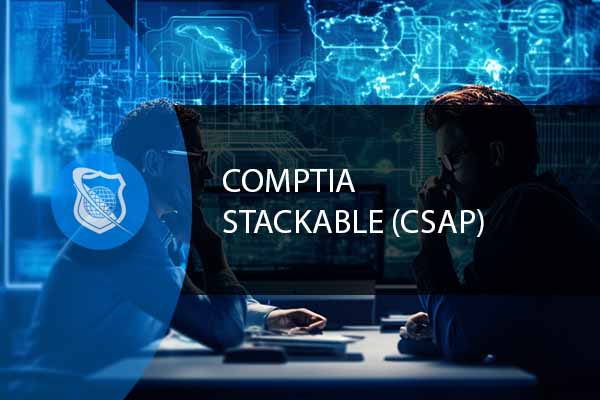CompTIA Security Analytics Professional (CSAP)
The CompTIA CSAP is a comprehensive certification that allows IT specialists with two to five years of experience the opportunity to stack their qualifications. To receive your CompTIA CSAP Certification, you must study and pass both the Security+ and CySA+ exams included in the provided learning materials from ITU.
Included In This Course



Closed Captions



Certificate of Completion

Those who earn the CompTIA Security Analytics Professional (CSAP) credential are security analytics professionals with the skills to design and execute effective protective measures for an organization’s computer networks and systems.
The CompTIA CSAP is a stackable certification by CompTIA. It is designed for IT professionals with 2 to 5 years of experience. The ITU Certification Path for the CompTIA CSAP certification consists of the learning materials to allow you to study for and pass the CompTIA Security+ and CompTIA CySA+ exams.
Special Offer! Take advantage of this incredible offer and get this IT course and more with our Master CompTIA Training Series containing 12 IT courses:
Completing this path and passing the two exams means you end of with two CompTIA certifications and are a designated a CompTIA Security Analytics Professional (CSAP).
The two courses contained in this path are:
Upon successfully passing the applicable exams provided by CompTIA, you will earn the CSAP certification badge.
For more information on CompTIA Stackable Certifications, visit the CompTIA website. Pricing charged by CompTIA varies by exam. For details on current pricing, visit CompTIA Pricing on their website.
This IT course covers the following career development areas
- Security risks and security threats, plus technical security challenges
- Core security functions related to cybersecurity threats
- Infrastructure roles including cloud computing environment
- Cloud computing fundamentals
Frequently Asked Questions About CompTIA Security Analytics Professional (CSAP)
What is the CompTIA Security Analytics Professional (CSAP) certification?
The CompTIA Security Analytics Professional (CSAP) is a comprehensive certification designed for IT professionals with 2 to 5 years of experience. The certification allows these professionals to stack their qualifications by passing both the Security+ and CySA+ exams.
What will I get access to when I subscribe for the training?
As part of the All Access Monthly Subscription, you will get access to this training as well as over 2,500 hours of on-demand content. The CompTIA CSAP certification course includes 30 training hours, 51 videos, 23 topics, and 246 practice questions.
What skills will I acquire upon completion of the CSAP certification?
By earning the CSAP certification, you’ll acquire skills such as Access Management, Application Security, Behavioral Analytics, Cybersecurity Analysis, Network Security, and Risk Management. These skills are critical for planning and implementing security measures to protect an organization’s computer networks and systems.
What are the prerequisites to earn the CSAP certification?
To earn the CSAP certification, you must pass both the CompTIA Security+ and CompTIA CySA+ exams. The study materials provided by ITU will help you prepare for these exams.
Who is the CSAP certification meant for?
The CSAP certification is intended for IT professionals with 2 to 5 years of experience who are looking to enhance their qualifications. It’s particularly suitable for security analytics professionals who are tasked with designing and implementing effective protective measures for an organization’s computer networks and systems.
Can I cancel my subscription to the training if I’m not satisfied?
Yes, you can cancel your subscription at any time without any obligation. The first 7 days of access are free, allowing you to explore the content before committing to the subscription.
Blogs of Interest Related to This Course
Proudly DisplayYour Achievement
Upon completion of your training, you’ll receive a personalized certificate of completion to help validate to others your new skills.
CompTIA Security+ SY0-601 (2022) Course Content
Module 1 - Introduction to Security
- 1.1 Introduction to Security
Module 2 - Malware and Social Engineering Attacks
- 2.1 Malware and Social Engineering Attacks
Module 3 - Basic Cryptography
- 3.1 Basic Cryptography
Module 4 - Advanced Cryptography and PKI
- 4.1 Advanced Cryptography and PKI
Module 5 - Networking and Server Attacks
- 5.1 Networking and Server Attacks
Module 6 - Network Security Devices, Designs and Technology
- 6.1 Network Security Devices, Designs and Technology
Module 7 - Administering a Secure Network
- 7.1 Administering a Secure Network
Module 8 - Wireless Network Security
- 8.1 Wireless Network Security
Module 9 - Client and Application Security
- 9.1 Client and Application Security
Module 10 - Mobile and Embedded Device Security
- 10.1 Mobile and Embedded Device Security
Module 11 - Authentication and Account Management
- 11.1 Authentication and Account Management
Module 12 - Access Management
- 12.1 Access Management
Module 13 - Vulnerability Assessment and Data Security
- 13.1 Vulnerability Assessment and Data Security
Module 14 - Business Continuity
- 14.1 Business Continuity
Module 15 - Risk Mitigation
- 15.1 Risk Mitigation
Module 16 - Security Plus Summary and Review
- 16.1 - Security Plus Summary and Review
Module 17 - Hands-On Training
- 17.1 Hands-On Scanning Part 1
- 17.2 Hands-On Scanning Part 2
- 17.3 Hands-On Advanced Scanning
- 17.4 Hands-On MetaSploit
- 17.5 Hands-On BurpSuite
- 17.6 Hands-On Exploitation Tools Part 1
- 17.7 Hands-On Exploitation Tools Part 2
- 17.8 Hands-On Invisibility Tools
- 17.9 Hands-On Connect to Tor
CompTIA CySA+ (Cybersecurity Analyst+) CS0-002 Course Content
Module 1: Threat and Vulnerability Management
- Instructor Intro
- About the Exam
- Test Taking Tips and Techniques
- Explain the importance of threat data and intelligence
- Given a scenario, utilize threat intelligence to support organizational security
- Given a scenario, perform vulnerability management activities Pt 1
- Given a scenario, perform vulnerability management activities Pt 2
- Given a scenario, analyze the output from common vulnerability assessment tools
- Explain the threats and vulnerabilities associated with specialized technology
- Explain the threats and vulnerabilities associated with operating in the Cloud
- Given a scenario, implement controls to mitigate attacks and software vulnerabilities Pt 1
- Given a scenario, implement controls to mitigate attacks and software vulnerabilities Pt 2
Module 2: Software and Systems Security
- Outline
- Given a scenario, apply security solutions for infrastructure management Pt 1
- Given a scenario, apply security solutions for infrastructure management Pt 2
- Given a scenario, apply security solutions for infrastructure management Pt 3
- Flashcards
- Explain software assurance best practices
- Scatter
- Explain hardware assurance best practices
- Learn
- Speller
- Workbook
Module 3: Security Operations and Monitoring
- Given a scenario, analyze data as part of security monitoring activities Pt 1
- Given a scenario, analyze data as part of security monitoring activities Pt 2
- Given a scenario, analyze data as part of security monitoring activities Pt 3
- Given a scenario, implement configuration changes to existing controls to improve security Pt 1
- Given a scenario, implement configuration changes to existing controls to improve security Pt 2
- Explain the importance of proactive threat hunting
- Compare and contrast automation concepts and technologies
Module 4: Incident Response
- Explain the importance of the incident response process
- Given a scenario, apply the appropriate the incident response procedure
- Given an incident, analyze potential indicators of compromise
- Given a scenario, utilize basic digital forensic techniques
Module 5: Compliance and Assessment
- Understand the importance of data privacy and protection
- Given a scenario, apply security concepts in support of organizational risk mitigation Pt 1
- Given a scenario, apply security concepts in support of organizational risk mitigation Pt 2
- Explain the importance of frameworks, policies, procedures, and controls Pt 1
- Explain the importance of frameworks, policies, procedures, and controls Pt 2
Module 6: Afterword
- Recap
- Review Questions
- Before the Exam
Your Training Instructors
Professor Brian O'Hare has over 25 years of experience in the IT industry. He started off in web design as a Corporate Webmaster but wanted to understand how the internet worked. While working towards his bachelor’s in computer science, he studied and got his MCSE (Microsoft Certified Systems Engineer) and his MCT (Microsoft Certified Trainer). Once certified he paid for his degree working as a Network Engineer and then a Trainer for others wanting to learn about Microsoft’s Desktop and Server products.
John is a Senior Technical Instructor at Ft. Gordon in Augusta, Georgia, instructing U.S. military and civilian employees on a number of cybersecurity subjects and certifications. He has been an IT professional for well over two decades, as prior to his current job he retired from the Army after a 20-year career as a soldier in the signal branch (IT and communications). John holds a bachelor’s degree in Computer Science from the University of Maryland Global Campus as well as the following IT certifications: Network+, Security+, Cybersecurity Analyst (CySA+), CompTIA Advanced Security Practitioner (CASP+), Certified Information Systems Security Professional (CISSP).

Subscribe To All-Access
Lock In $16.99 / Month Forever
Access this course and over 2,700 hours of focused IT training. Start your first month for only $1.00. Then lock in only $16.99 / month for life.
- Get Every Course
- Free Updates / New Content Added
- 2,700+ Hours of Training
- Price Lock Guarantee
- Games / Flashcards
- 21,000+ Practice Questions
$49.99 $16.99 Monthly
$59.00







good
Smooth delivery and easy access to LMS. Good to see that the LMS offers progress tracking. Would be great if badges were offered on completion of courses to share via Credly to future employers.